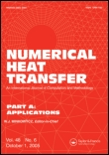
NUMERICAL HEAT TRANSFER PART A-APPLICATIONS
Scope & Guideline
Transforming theoretical concepts into practical applications in heat transfer.
Introduction
Aims and Scopes
- Numerical Simulation of Heat Transfer Phenomena:
The journal extensively publishes studies that employ numerical simulations to analyze various heat transfer phenomena, including conduction, convection, and radiation in different geometries and materials. - Nanofluid Applications:
A significant area of focus is the investigation of nanofluids, which are fluids engineered by suspending nanoparticles. This includes studies on their thermal properties, heat transfer enhancements, and applications in cooling systems. - Magnetohydrodynamics (MHD):
Research involving MHD explores the interaction between magnetic fields and electrically conducting fluids, particularly in the context of heat transfer and fluid flow in engineering applications. - Bioconvection and Biological Fluids:
The journal includes studies on bioconvective flows and the thermal behavior of biological fluids, highlighting the importance of heat transfer in biomedical applications. - Entropy Generation and Thermodynamic Analysis:
Papers often discuss entropy generation in thermal systems, providing insights into efficiency and sustainability in heat transfer processes. - Phase Change Materials (PCMs):
The application of phase change materials for thermal energy storage and management is a recurring theme, focusing on their heat transfer characteristics and performance in various systems. - Advanced Cooling Techniques:
Research on innovative cooling techniques, including microchannel heat sinks, heat exchangers, and enhanced cooling strategies for high-performance applications, is prominently featured.
Trending and Emerging
- Hybrid Nanofluids:
There is a growing interest in hybrid nanofluids, which combine multiple nanoparticles to enhance thermal properties, offering promising applications in advanced cooling technologies. - Machine Learning and AI in Heat Transfer:
The integration of machine learning and artificial intelligence techniques in analyzing heat transfer phenomena and optimizing thermal systems is on the rise, indicating a trend towards data-driven approaches. - Sustainable Thermal Management Solutions:
Research focused on sustainable and energy-efficient thermal management solutions, including the use of renewable energy sources and eco-friendly materials, is increasingly prevalent. - Complex Geometries and Advanced Manufacturing Techniques:
Studies exploring heat transfer in complex geometries, enabled by advanced manufacturing techniques such as 3D printing, are emerging, highlighting the need for innovative cooling solutions in modern engineering. - Thermal Performance of Energy Systems:
There is an increasing focus on the thermal performance of energy systems, particularly in the context of renewable energy integration and the efficiency of thermal energy storage systems.
Declining or Waning
- Traditional Heat Exchangers without Nanofluids:
There has been a noticeable decline in studies focused solely on traditional heat exchangers without the incorporation of nanofluids or advanced materials, as the field shifts towards more innovative cooling solutions. - Simplistic Analytical Models:
The reliance on simplistic analytical models for heat transfer analysis has decreased, as researchers increasingly prefer more complex numerical simulations that better capture real-world phenomena. - Single-Phase Flow Studies:
Research solely focused on single-phase flows is less common, with a shift towards multi-phase flows that include interactions with nanofluids or bioconvection. - Basic Convection Studies:
Basic studies on convection in simple geometries are becoming less frequent, as researchers explore more complex geometries and conditions that reflect practical engineering applications.
Similar Journals
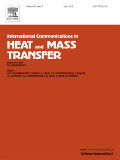
INTERNATIONAL COMMUNICATIONS IN HEAT AND MASS TRANSFER
Illuminating the pathways of thermal and mass transfer.INTERNATIONAL COMMUNICATIONS IN HEAT AND MASS TRANSFER, published by Pergamon-Elsevier Science Ltd, stands at the forefront of research in the fields of heat and mass transfer, making significant contributions to the knowledge base since its inception in 1983. With an impressive reputation reflected in its 2023 Q1 rankings in Atomic and Molecular Physics, Chemical Engineering, and Condensed Matter Physics, this journal appeals to a wide spectrum of scholars, professionals, and advanced students engaged in these critical disciplines. The journal is indexed under ISSN 0735-1933 and E-ISSN 1879-0178, and it maintains a rigorous peer-review process to ensure the high quality of published papers. Although not an Open Access journal, its strategic importance is underscored by its ranking in Scopus with notable positions in various sub-disciplines, securing its place in the elite 89th to 93rd percentiles. For those looking to deepen their understanding and contribute to advancements in thermal and mass transfer phenomena, INTERNATIONAL COMMUNICATIONS IN HEAT AND MASS TRANSFER serves as an essential resource for cutting-edge research and innovative applications.

Journal of Nanofluids
Transforming Fluid Dynamics with Cutting-edge NanotechnologyJournal of Nanofluids, published by AMER SCIENTIFIC PUBLISHERS, is a leading international journal dedicated to the burgeoning field of nanofluid technology which bridges the areas of fluid dynamics and nanotechnology. With an ISSN of 2169-432X and E-ISSN of 2169-4338, this journal has established itself as a valuable resource for researchers and professionals in Mechanical Engineering and Chemical Engineering, particularly in the domains of fluid flow and transfer processes. Its prestigious standing is reflected in the 2023 Scopus rankings, positioning it in the 79th percentile for Mechanical Engineering and the 78th percentile for Fluid Flow and Transfer Processes. Although coverage has been discontinued in Scopus since 2021, the journal maintains a Q2 category ranking in both relevant fields, emphasizing its commitment to high-quality and impactful research dissemination. This journal aims to foster innovation and collaboration among scientists and engineers worldwide, providing a platform for groundbreaking research, reviews, and discussions on nanofluids, their properties, and applications. As an essential addition to the library of any researcher or student vested in advanced fluid dynamics, the Journal of Nanofluids serves as a pivotal conduit for advancing knowledge and technology in this exciting and evolving field.

Journal of Engineering Thermophysics
Catalyzing breakthroughs in thermal dynamics and engineering applications.Journal of Engineering Thermophysics, published by PLEIADES PUBLISHING INC, is a premier academic journal dedicated to advancing the field of thermophysics and its applications across a variety of engineering disciplines. With an ISSN of 1810-2328 and an E-ISSN of 1990-5432, this journal offers an essential platform for researchers and professionals to disseminate cutting-edge findings on the interplay between thermal processes and engineering systems. As of 2023, it is recognized within the Q3 category in key fields such as Condensed Matter Physics, Energy Engineering and Power Technology, Environmental Engineering, and Modeling and Simulation. Moreover, the journal contributes to an important dialogue in the environmental sciences, ranking 111 out of 197 in Environmental Engineering, and positions itself prominently within the academic landscape from its establishment in 2007. Although currently not an open-access journal, it facilitates a selective yet impactful communication of research that drives innovation and knowledge in the thermal sciences. For those engaged in understanding the thermal dynamics essential for sustainable engineering solutions, the Journal of Engineering Thermophysics is the go-to resource for published research, reviews, and advancements in the field.

Interfacial Phenomena and Heat Transfer
Catalyzing Research in Heat Transfer and Interfacial PhenomenaInterfacial Phenomena and Heat Transfer is a leading academic journal published by BEGELL HOUSE INC that has rapidly established itself as an essential resource for scholars and industry experts in the fields of engineering, fluid flow, and chemical processes. With an ISSN of 2169-2785 and E-ISSN 2167-857X, this journal focuses on the critical interdisciplinary aspects of heat transfer and interfacial phenomena, offering insights that span across mechanical engineering, chemical engineering, and physical sciences. Despite its relatively recent inception in 2017, it has garnered respectable recognition, with a 2023 Scopus rank placing it in the Q3 category within the disciplines of Engineering (miscellaneous) and Fluid Flow and Transfer Processes, making it a pertinent publication for those interested in cutting-edge research. As researchers and professionals navigate the complexities of interfacial dynamics, Interfacial Phenomena and Heat Transfer serves as a pivotal platform, publishing high-quality, peer-reviewed articles that aim to advance knowledge and stimulate further investigation in this increasingly vital domain.

Journal of Thermal Science
Transforming thermal science into practical solutions.Journal of Thermal Science is a prestigious academic publication dedicated to the field of thermal science and its applications. Published by SPRINGER, this journal has been at the forefront of knowledge dissemination since its inception in 1992 and continues to provide a platform for researchers and professionals to share their innovative findings through high-quality peer-reviewed articles. With its ISSN 1003-2169 and E-ISSN 1993-033X, the journal covers a diverse array of topics related to thermal processes, materials, and engineering, significantly contributing to advancements in Condensed Matter Physics. In the latest rankings, it holds a commendable Q2 category in the 2023 quartiles, further highlighting its relevance with a Scopus ranking of #183/434 in its field, placing it in the top 57th percentile. While currently not offering open access, the journal strives to bridge the gap between theory and practice, making substantial impacts on both academia and industry. Its continued exploration of cutting-edge research ensures that it remains a key resource for students and professionals looking to expand their knowledge and foster innovation in thermal sciences.
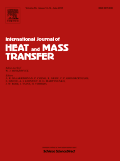
INTERNATIONAL JOURNAL OF HEAT AND MASS TRANSFER
Unraveling Complex Interactions in Engineering and ScienceINTERNATIONAL JOURNAL OF HEAT AND MASS TRANSFER is a premier, peer-reviewed academic journal published by PERGAMON-ELSEVIER SCIENCE LTD, focusing on the vital fields of condensed matter physics, fluid flow, and transfer processes, as well as mechanical engineering. With an impressive impact factor and consistently ranked in the Q1 quartile across multiple engineering and physics categories, this journal stands out for its rigorous scholarship and relevance to advancements in heat and mass transfer phenomena. Spanning from 1960 to 2024, it serves as a critical platform for researchers and professionals aiming to disseminate innovative findings and foster cutting-edge discussions in these interconnected domains. Though it operates on a subscription model, readers benefit from a comprehensive archive that covers seminal studies and contemporary advancements. Academics and practitioners alike can deepen their understanding of the complex interplay between heat and mass transfer, which is essential for numerous applications in engineering and scientific research.
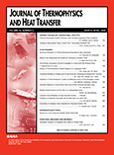
JOURNAL OF THERMOPHYSICS AND HEAT TRANSFER
Empowering Researchers in Thermophysics and BeyondJOURNAL OF THERMOPHYSICS AND HEAT TRANSFER, published by the American Institute of Aeronautics and Astronautics, serves as a vital platform for the dissemination of cutting-edge research in the fields of thermophysics and heat transfer. With an ISSN of 0887-8722 and an E-ISSN of 1533-6808, this journal has been pivotal in enhancing our understanding of heat transfer mechanisms since its inception in 1987, continuing through 2024. It occupies a noteworthy position in various academic categories, boasting Q2 rankings in both Fluid Flow and Transfer Processes and Mechanical Engineering, reflecting its significant contribution to the engineering and physical sciences community. Although it currently does not offer Open Access options, the journal’s repository of rigorous peer-reviewed articles remains accessible to researchers, professionals, and students eager to expand their knowledge and apply innovative findings in aerospace, condensed matter physics, and planetary sciences. Emphasizing both theoretical and experimental approaches, the JOURNAL OF THERMOPHYSICS AND HEAT TRANSFER remains an indispensable resource for advancing the frontiers of engineering and applied sciences.

Frontiers in Heat and Mass Transfer
Exploring Innovative Research in Heat and Mass TransferFrontiers in Heat and Mass Transfer is a premier open-access journal published by TECH SCIENCE PRESS that focuses on the interdisciplinary field of heat and mass transfer. Established in 2010, this journal has been pivotal in disseminating high-quality research aimed at advancing the understanding of energy and material transport phenomena. With an impressive commitment to open access, it ensures that all published articles are readily available to researchers, practitioners, and students globally, promoting knowledge sharing and collaboration. The journal currently holds a Q3 ranking in key categories such as Engineering, Materials Science, and Physics and Astronomy, as well as notable positioning in Scopus rankings. With a forward-looking scope extending from 2010 to 2024, Frontiers in Heat and Mass Transfer continues to be an essential platform for innovative research, fostering the development of practical applications across various scientific and engineering domains. We invite you to explore the latest contributions to this evolving field and consider this journal as a vital resource for your academic and professional growth.
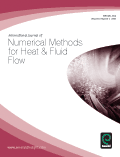
INTERNATIONAL JOURNAL OF NUMERICAL METHODS FOR HEAT & FLUID FLOW
Transforming Complex Fluid Flow Challenges into Solutions.INTERNATIONAL JOURNAL OF NUMERICAL METHODS FOR HEAT & FLUID FLOW, published by EMERALD GROUP PUBLISHING LTD, is a premier platform dedicated to advancing the field of numerical methods applied to heat and fluid flow analysis. With an ISSN of 0961-5539 and an E-ISSN of 1758-6585, this journal has been a vital resource since its inception in 1991, covering cutting-edge research right up to 2024. It is highly regarded within various disciplines, as evidenced by its impressive ranking in the 2023 Scopus categories, which places it in the Q1 tier for Computational Mechanics and a Q2 tier for Aerospace Engineering and Mechanical Engineering. This authoritative journal holds significant importance for researchers, professionals, and students who are keen on expanding their knowledge and addressing challenges in thermal and fluid dynamics through innovative computational techniques. Although the journal does not provide Open Access options, its rigorous peer-review process and high-impact publication standards ensure that it remains an essential tool for those involved in engineering advancements and applied mathematics.

ASME Journal of Heat and Mass Transfer
Pioneering Insights in Thermal EngineeringASME Journal of Heat and Mass Transfer, published by the renowned American Society of Mechanical Engineers (ASME), is a pivotal journal in the fields of mechanical engineering and materials science. With its ISSN 2832-8450 and E-ISSN 2832-8469, this journal aims to disseminate high-quality research focused on the principles and applications of heat transfer and mass transfer phenomena. Despite its recent launch, having converged from 2023 to 2024, it has quickly established a significant presence in the academic community, holding respectable rankings within the Scopus database across various categories—including a 66th percentile rank in Mechanical Engineering. The journal endeavors to foster innovation and collaborative research that advance the frontiers of knowledge in thermal sciences, making it an essential resource for researchers, practitioners, and students keen on exploring the challenges and developments in heat and mass transfer technologies. The journal also embraces an open-access model, ensuring that leading research reaches a broader audience and contributes to global knowledge sharing.